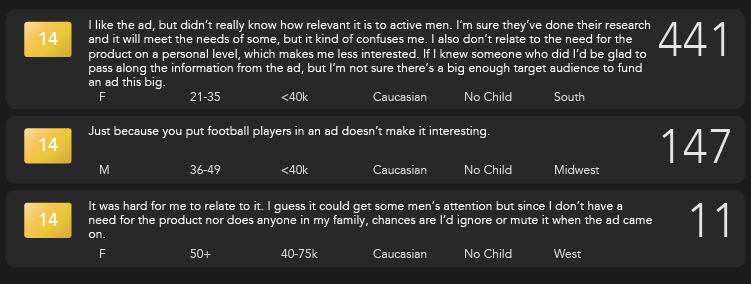The Warc 100 list evaluates campaigns from around the world each year—using 75 different creative effectiveness and strategy awards—to compile a list of the smartest and most effective marketing campaigns. It focuses on campaigns that were not only creatively and strategically effective, but that also had a positive effect on consumer behavior and business performance.
At Ace Metrix, we believe that advertising should both build brands and sell products, using great creative to achieve that. It’s why we measure the effectiveness of every piece of creative that breaks nationally – whether you are a client or not. It’s also why we have examples of almost every campaign on the WARC list. Unsurprisingly, the WARC winners stood out in the Ace Metrix platform as well – great creative matters and can be measured – something that is proven every time a list like this comes out. In fact, many of the ads were the best in their categories or the best ever from the brand. Even when they were not the best in the category, the reason was generally clear and requires a simple look at the target audience. While we score every ad with a general population sample because the TV audience is broad, we can also reveal the gender/age differences to uncover success against specific ad targets – just as Chevy did with its Sonic ads.
M&M’s “Not Your Average Chocolate” campaign was ranked #48 on the Warc 100 list and contained the highest scoring ad of the 13 U.S. campaigns. The “Just My Shell” ad, that originally aired during the 2012 Super Bowl, came in with a strong Ace Score of 671, 18% above the current Candy & Gum category norm. “Just My Shell,” in fact, is the third highest scoring ad in the Candy & Gum category since we began scoring in 2010.
Women scored the ad 10% higher than men, and women ages 21-35 awarded the ad a score above 700, the highest of any gender/age demographic.
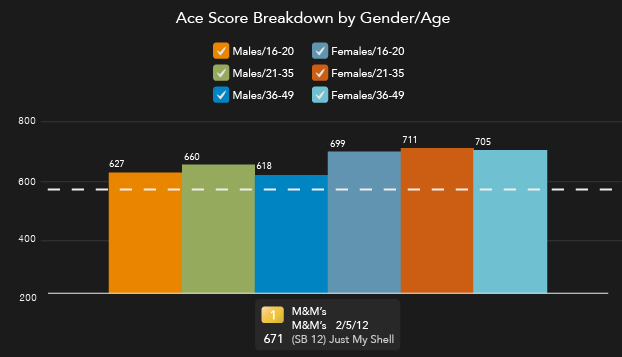
Regardless of gender or age, the ad was extremely well received, with every age group scoring it well above the norm. Likeability, Attention and Desire each surpassed the norms by more than 100 points with Attention, coming in at 776, scoring nearly 19% above the norm and Likeability (786), nearly 21% above the norm for the Candy & Gum category.
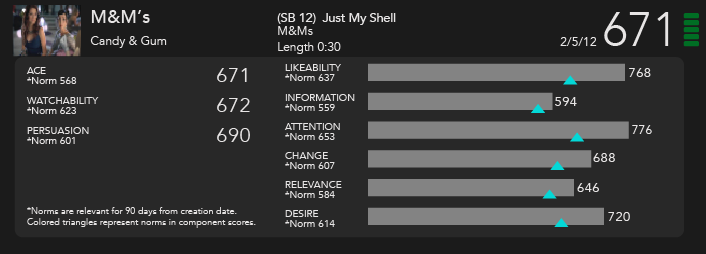
The high Likeability score was evidenced in the optional verbatim responses, with 34% of respondents describing the ad as “funny,” along with 12% using the word “love” and 10% using the words “good” and “cute.”
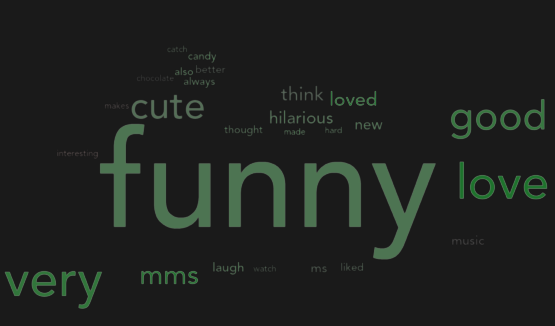
The follow-up ad in the campaign, “Pure Milk Chocolate On The Inside,” also scored well (624), but not nearly as well as the flagship ad.
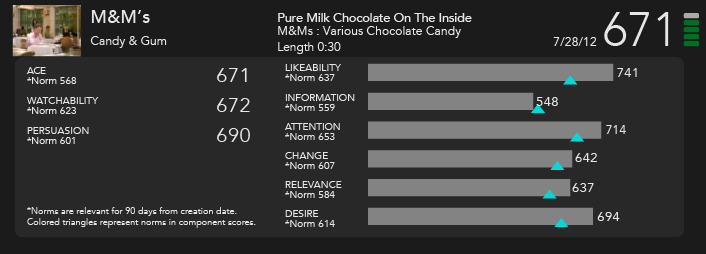
P&G’s “Thank You, Mom” campaign achieved a top 5 spot on the Warc 100 list—an incredible accomplishment. Their highest scoring ad, “Try Again Wieber,” that originally aired during the 2012 Summer Olympics, had an equally strong Ace Score of 660, 9% above the Corporate Branding norm.
“Try Again Wieber” had the greatest impact with 36-49-year-olds, with females giving the ad a score of 699, 16% above the norm, and males giving it a score of 657, 9% above the norm.
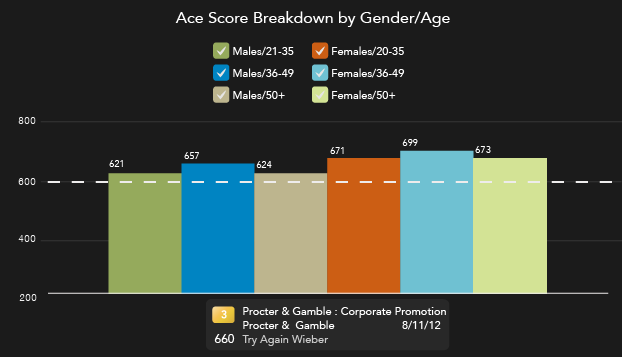
Like the M&M’s ad, “Try Again Wieber” resonated with every age group and gender. The ad generated high Likeability and Attention scores, both breaking 740 (748 and 742, respectively).
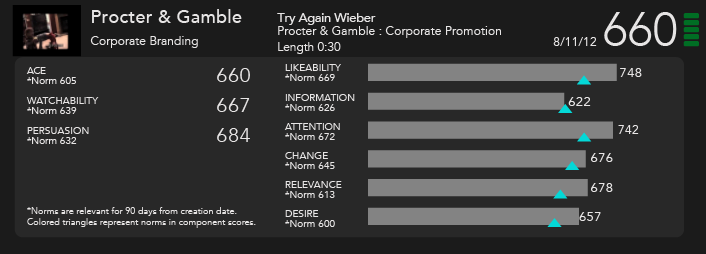
What was perhaps most interesting about “Try Again Wieber” was its Emotional Sentiment score. It achieved a score of 70, not only 30% higher than the category norm but also 37% higher than the overall norm for Emotional Sentiment.
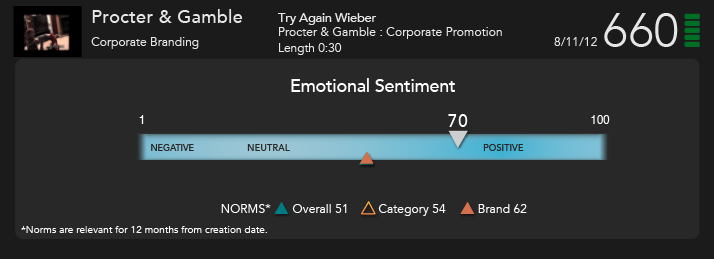
This Emotional Sentiment score also contributed to viewers appreciating the message of the ad, seen in the optional verbatim responses:

With over 30 pieces of creative aired in 2012 alone, P&G’s campaign certainly grabbed consumer’s attention.
Samsung’s “The Next Big Thing is Already Here” campaign reached #12 on the Warc 100 list. This campaign’s best performing ad was “The Next Big Thing is Already Here, NYC” which had an Ace Score of 647, 5% above the norm for Mobile Devices.
Women scored “The Next Big Thing is Already Here, NYC” nearly 8% higher than men. Women ages 21-49 scored the ad particularly high, almost 11% higher than the norm.
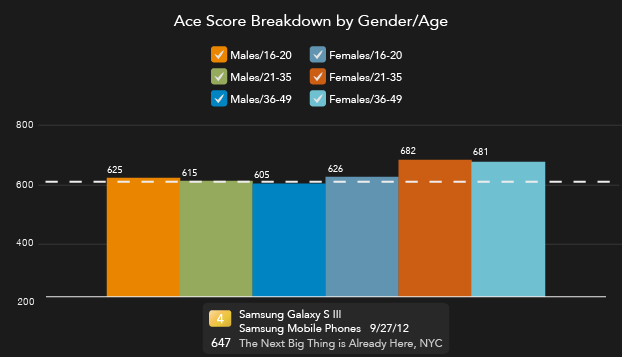
As seen in the chart above, this ad didn’t score as well with males 21-49, and the verbatim responses give a reason for the lower scores. Seven percent of the male 21-35 verbatim responses mentioned “apple” and 5% mentioned “iphone,” many in a way that showed their Apple loyalty. Therefore, males ages 21-35 scored the ad much lower (553) because they prefer Apple products to Samsung ones. Because of the “poking fun” nature of this ad, the audience found themselves in an “Apple vs. Samsung” battle, leaving their personal preferences to affect the scores.

As expected, 7% of males 21-35 mentioned “Samsung” in their responses.

Despite the lower male scores, the ad still managed to score 717 on two component scores (Likeability and Change).
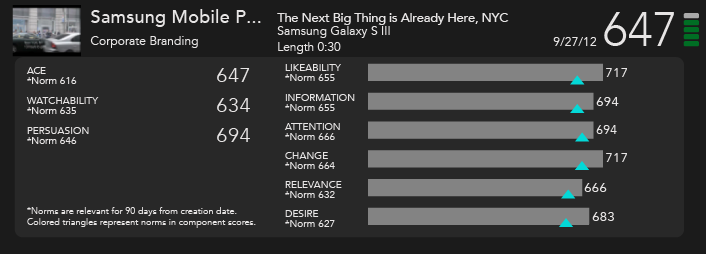
Likeability was 9% higher than the category norm, and this, once again, translated into positive verbatim responses. Respondents used words like “good” (12%), “cool” (9%), “love” (8%), “new” (8%) and “want” (6%).
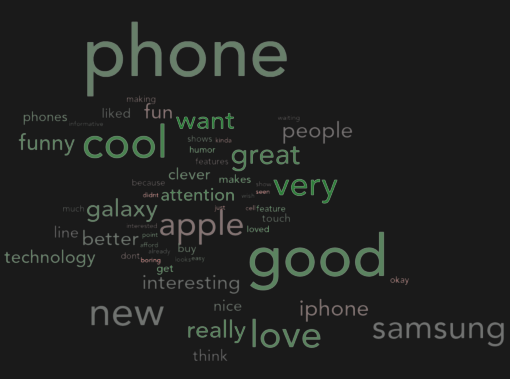
American Express’ “Small Business Saturday” campaign reached a very impressive ranking of #2 on the Warc 100 list. The first ad of the campaign, “Shopping on Small Business Saturday,” has a very strong Ace Score of 640. The ad clearly shows why this campaign was ranked so highly on the Warc 100 list, as it is the second highest ranking ad of all time in the Credit Cards category (MasterCard’s “Stand Up to Cancer” is #1).
This ad did extremely well with females ages 50+, who scored it 727, 31% above the category norm.
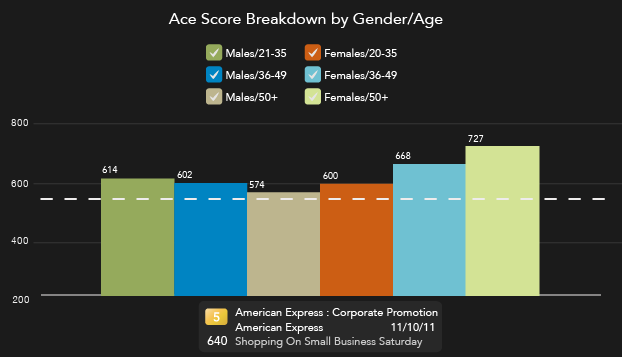
This ad scored very well with both genders and all ages, which explains why it had four component scores break 700. The most significant were its Relevance score of 700, 23% above the 90-day category norm, and its Desire score of 659, 19% above the norm.
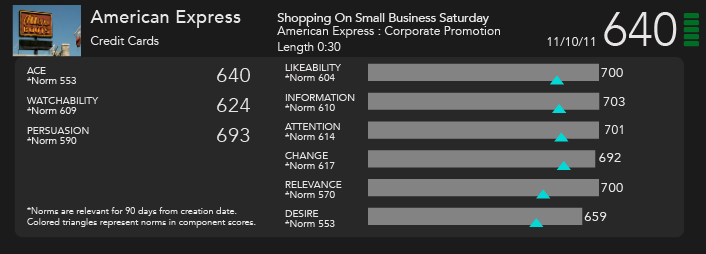
These high scores were also reflected in the positive verbatim responses in which 16% of responses described the ad as “good” and 14% as “great.” Perhaps more importantly, the consumer comments tell us how well the ad’s message struck a chord with the viewers. Seventeen percent of respondents used the word “businesses,” 13% used “idea,” 11% used “shop” and 7% used “American” or “message.”
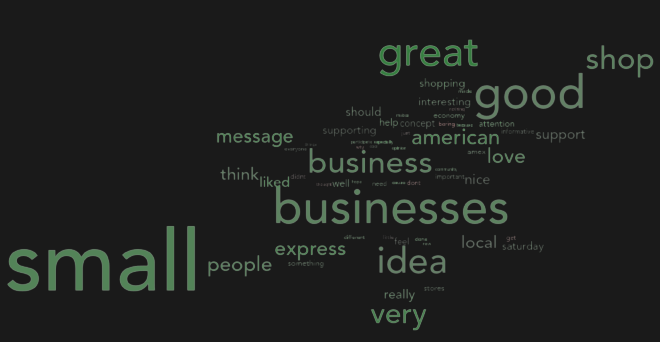
Follow-up ads did well, but not quite as well as “Shopping on Small Business Saturday.”
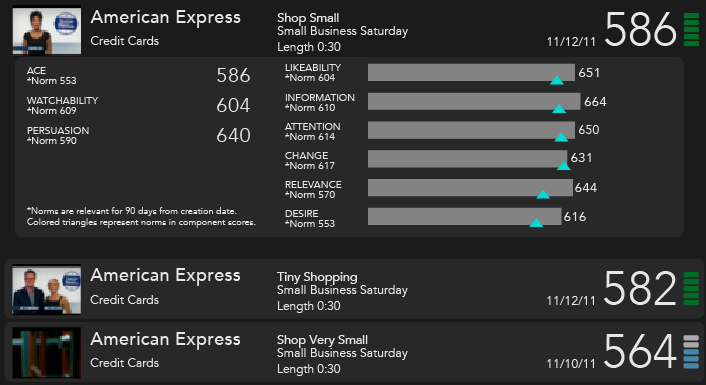
Nike’s “Find Your Greatness” campaign is ranked #67 on the Warc 100 list and contains Nike’s highest scoring ad to date. Originally airing during the 2012 Summer Olympics, “Find Your Greatness” achieved an Ace Score of 618, nearly 23% above the Footwear category norm.
“Find Your Greatness” performed exceptionally well with 16-20 year olds—females awarding it a score of 687, almost 36% above norm, and males giving it a score of 653, nearly 30% above norm.
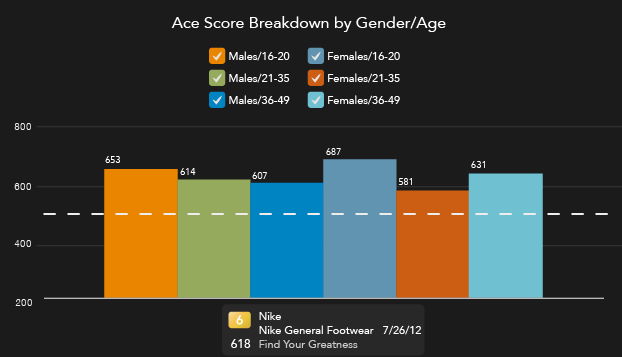
The ad was still well received by all genders and ages. Every component score far exceeded the category norms. The most prominent were Information (631), 20% above norm; Relevance (677), nearly 36% above norm and Attention (708), 14% above the norm.
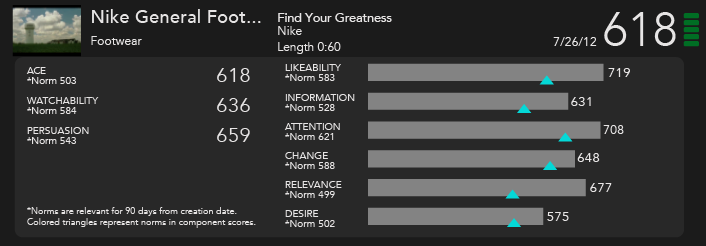
What was even more impressive was the ad’s clear ability to convey its message to the consumer. Respondents used words such as “greatness” (6%), “inspiring” (6%), “message” (8%), “think” (10%) and “nike” (8%) when describing their thoughts and feelings on the ad.


Nike aired 13 more ads as part of this campaign that were not nearly as successful – with most scoring at or below the category norm. Needless to say, the debut ad, “Find Your Greatness,” was clearly where this campaign found its greatness.
Chipotle’s “Cultivate a Better World” campaign ranked #28 on the Warc 100 list. While this campaign didn’t have very many ads, it certainly made its main ad, “Scarecrow,” count. The ad achieved an Ace Score of 601. “Scarecrow skewed to younger viewers (21-35-year-olds), with females giving it a score of 653, 10% above the QSR category norm, and males awarded it a score of 663, 12% above norm.
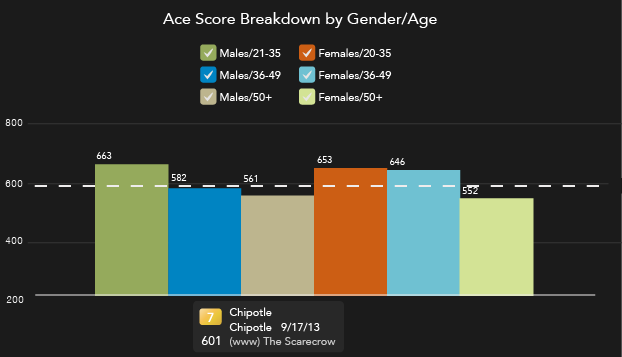
What was particularly noticeable about the ad was its high Attention component score (732), which is 11% higher than the category norm. This is particularly noteworthy considering the ad is 3 minutes and 20 seconds long.
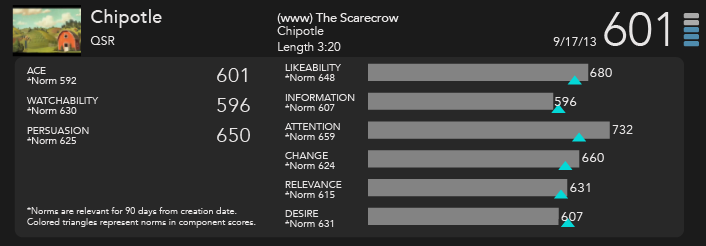
As expected, the ad’s length was clearly marked in the verbatim responses, with a whopping 25% of respondents using the word “long” and awarding the ad a below-norm score.
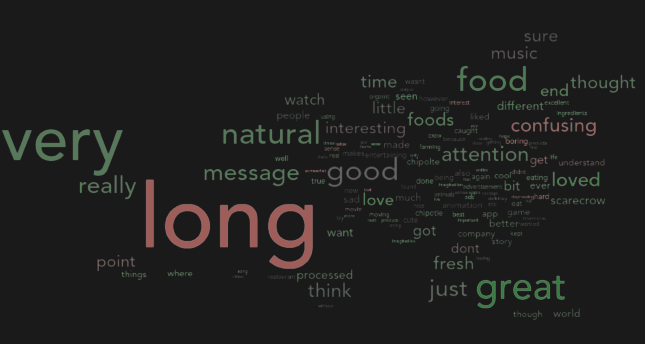
Interestingly, not many consumers mentioned “Chipotle” directly, and some viewers (6%) even found the ad confusing.
Despite the length, the verbose, positive, optional responses certainly explain the ad’s 601 Ace Score.
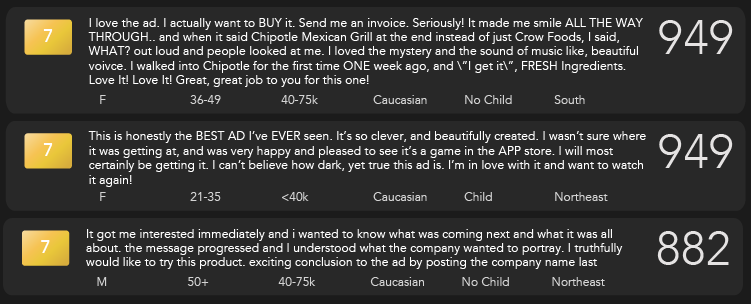
Kraft’s “We Know You’re Going to Love It” campaign ranked #26 on the Warc 100 list. The highest scoring ad of this campaign is “Son Bribes Dad to Watch a Movie”, which came in with an Ace Score of 595, 5% above the Meals category norm.
The ad did extremely well with 36-49-year-old females, who awarded the ad a score of 686, 21% higher than the current 90-day norm.
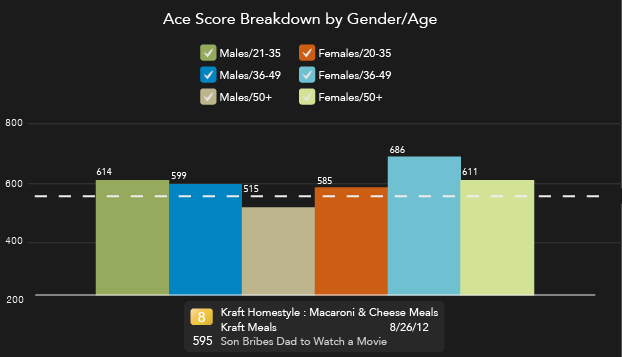
Conversely, males ages 50+ didn’t seem to connect with the ad, scoring it an Ace Score of 515, well below the norm. This low-scoring demographic aside, the ad performed very well with all other gender/age groups. The ad also scored 13% higher with consumers who live with children under the age of 18 (650).
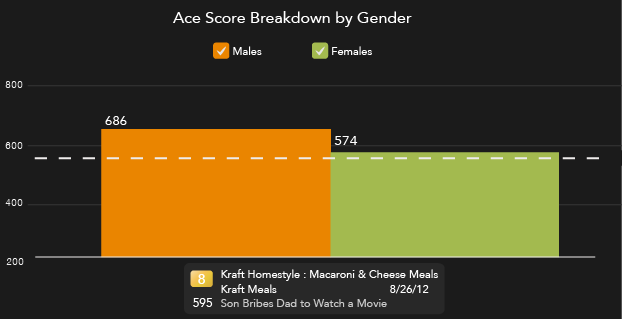
Additionally, the ad evoked a high Desire score (649), 5% above the category norm.
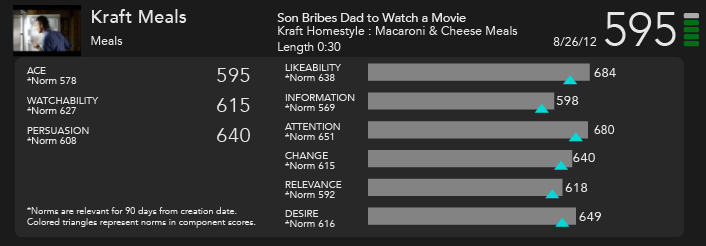
The high Likeability score was seen in the verbatim responses, in which respondents used words such as “funny” (15%), “cute” (15%), “good” (12%) and “great” (10%) to describe the ad.
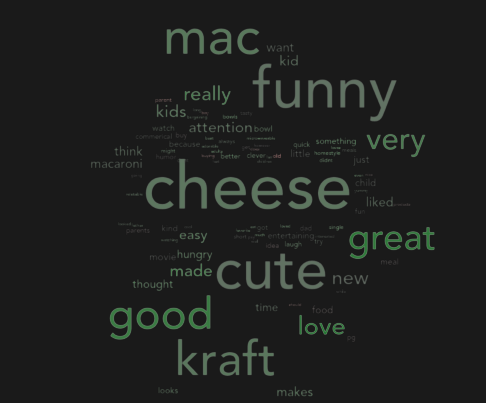
Febreze’s “Febreze Olympics” campaign achieved a ranking in the top 40 of the Warc 100 list, coming in at #38. The highest scoring ad of this campaign, “Wrestling Team Gym Experiment :15,” has an Ace Score of 589, below norm for the Deodorizers category.
Despite the lower-than-norm score, “Wrestling Team Gym Experiment :15” did resonate with female consumers. Females scored the ad nearly 12% higher than men, with an average Ace Score of 628, a score that is above the category norm.
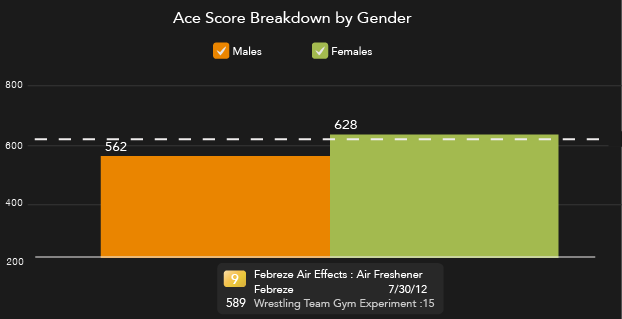
While the ad was below norm in nearly every component score, with Information at the lowest, the ad did beat the norm with its Desire score. Notably, all female-only component scores beat the category norms, so the ad clearly skewed to female viewers.
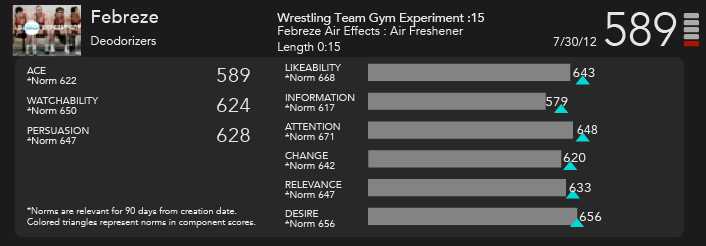
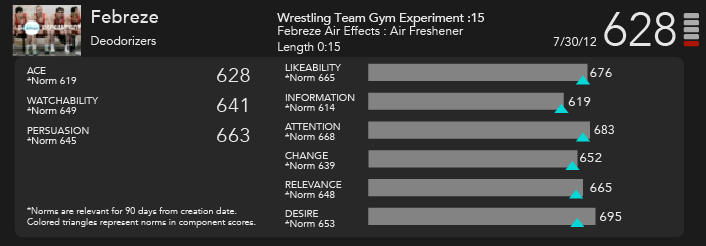
*Above chart is based on female scores.
Verbatim responses showed very strong brand recognition, with 22% of responses mentioning “febreze” or “febreeze.”
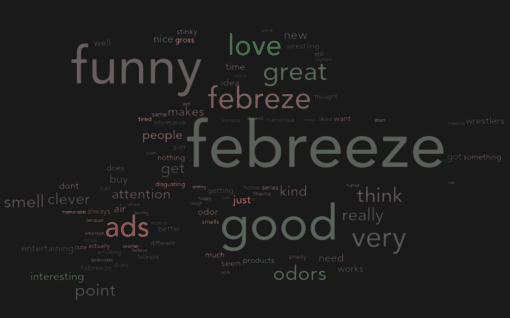
Similarly, many of the verbatim comments pointed to a love and appreciation for the product, but not for the ad.

Slim Jim’s “Man Medicine” campaign certainly should be proud of its #51 spot on the Warc 100 list. One of the first ads in the campaign, “Baby Shower,” remains its highest scoring ad, with an Ace Score of 587, 3% higher than the Snacks category norm.
Despite having a “manly” theme, “Baby Shower” didn’t score significantly better with males over females. That being said, males ages 16-20 years old scored this ad extremely well with an Ace Score of 640, 12% above the category norm. The ad also scored surprisingly well with 36-49-year-old females who gave it a 595.
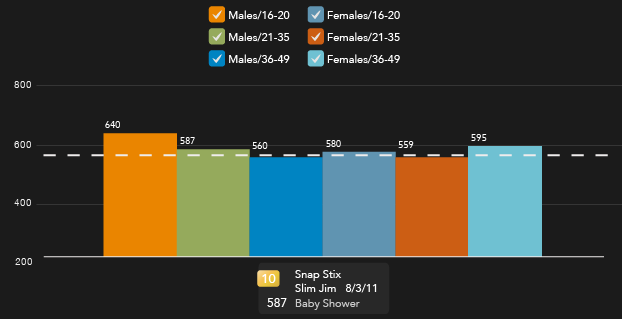
“Baby Shower” generated high Likeability (674), Attention (689), Change (643) and Desire (627) scores. Relevance struggled a bit, coming in below norm.
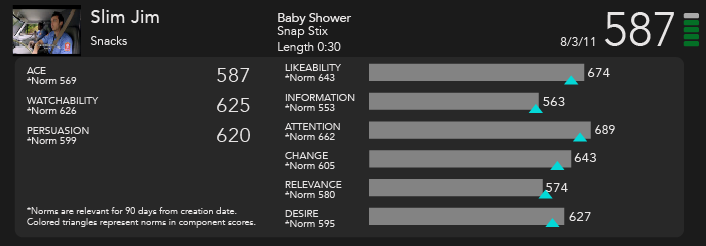
Verbatim responses clearly pointed to the high Likeability and Attention scores, with 23% describing the ad as “funny,” 11% as “good” and 8% using the word “attention.” “Slim Jim” was also very apparent.
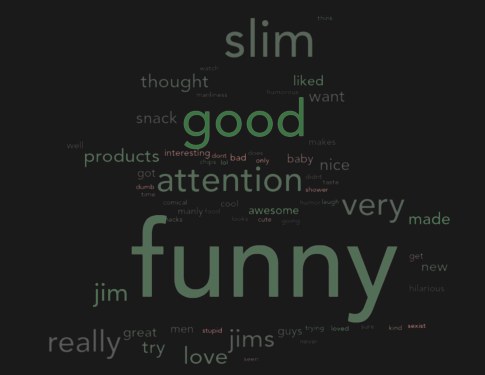
The other ads in this campaign didn’t score as well, mostly because of a more prominent “Man Medicine” theme, which caused females to score the ads far lower.
Chevrolet’s “Sonics Firsts” campaign achieved a top 40 Warc 100 list ranking, coming in at #34. While the campaign originated online, Chevrolet aired a series of commercials from this campaign, its most successful being “Sonic Stunt Anthem.” This ad has a 569 Ace Score, which is just above the Non-Luxury Auto category norm.
Men scored the ad nearly 9% higher than women, with 21-35-year-old male scores giving the highest score. This gender/age group scored the ad 13% higher than the category norm, which certainly speaks to the gender gap.
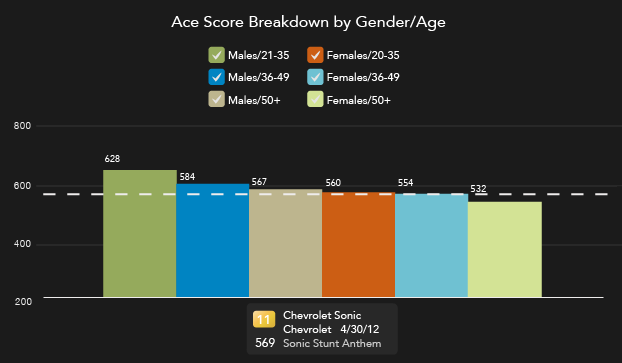
The ad blew away the norm with a high Attention score of 731, almost 15% above the category norm. The ad also had high Likeability and Change scores. What this ad lacked, however, was Relevance, Information and Desire.
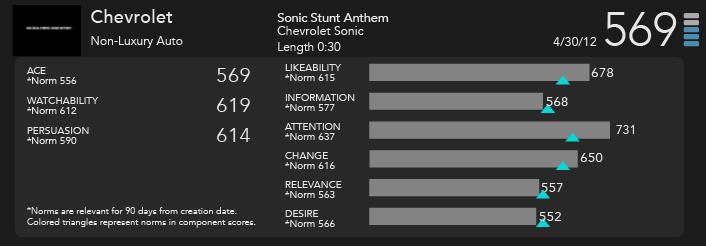
These component scores were highlighted in the verbatim responses, with 12% using the word “attention” and 10% using “cool.” “Car” (21%) and “stunts” (9%) were mostly used in a negative context, mostly because the ad was lacking information.
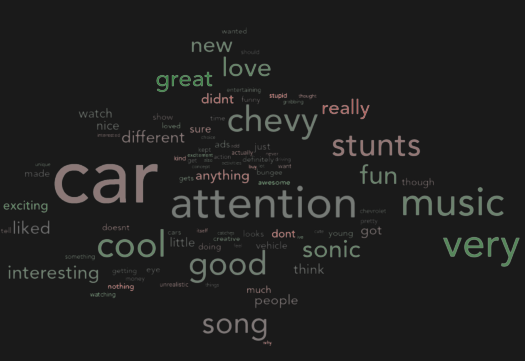
Responses indicated that viewers didn’t really see the connection between the stunts and the car’s actual performance.
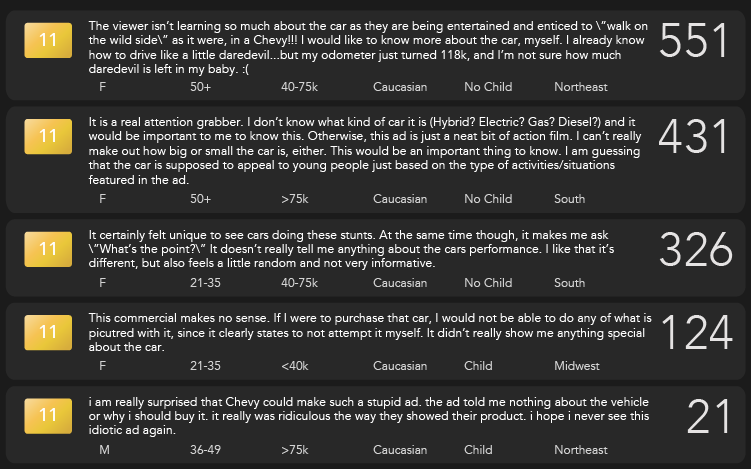
The other ads that aired during this campaign had lower scores as well, and similar consumer responses. Needless to say, the ad certainly captured the attention of viewers both online and on TV.
Ad Council’s “GED Pep Talk Center” campaign received a #58 ranking on the Warc 100 list. Its highest scoring ad, “Pep Talk (Jerry Stiller)” has an Ace Score of 519, which is below the Corporate Branding norm.
While this ad may be polarizing simply because getting a GED doesn’t apply to a very wide audience, it scored well with 21-35-year-old males. They scored the ad at 614, just above the category norm.
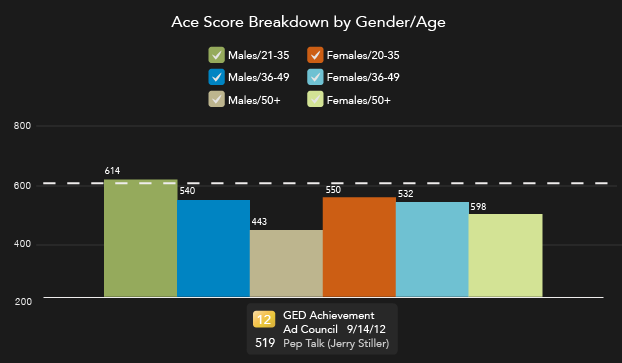
The Attention score of 681 surpassed the norm, but the ad struggled with Relevance and Desire. Again, this is most likely because the ad doesn’t really apply to the majority of viewers.
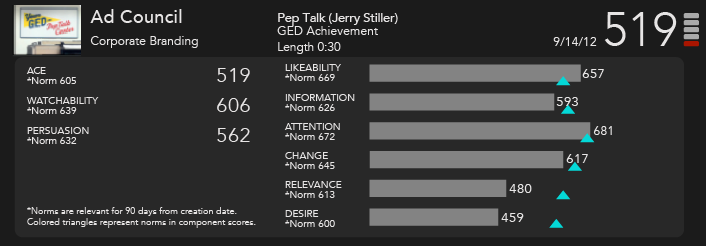
Verbatim responses pointed to the high Attention score, with 20% using the word “attention.” People also seemed to understand the theme of the ad, with 46% using “GED,” 12% using “education” and 14% using “school.”

Responses also highlighted the segmentation in the viewing audience this ad produced.

Axe’s “Susan Glenn” campaign achieved #78 on the Warc 100 list. While this was a digital campaign, Ace Metrix has scored its main ad, “Kiefer Sutherland.” It has an Ace Score of 486, below the Fragrance category norm.
As expected, the ad skewed male, with 16-20-year-old males giving it a relatively high score of 604, 11% above the category norm. Males, in general, scored the ad 17% higher than females.
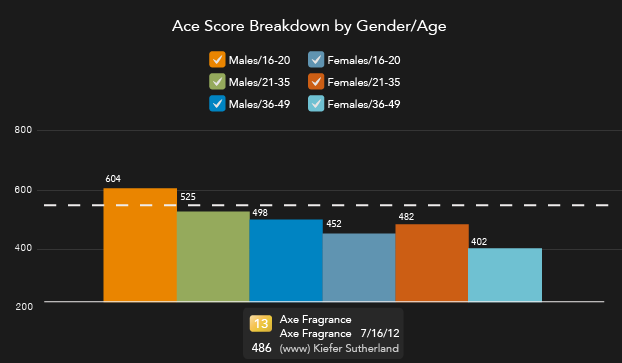
In addition to the gender skew, this ad especially lacked Information and Desire.
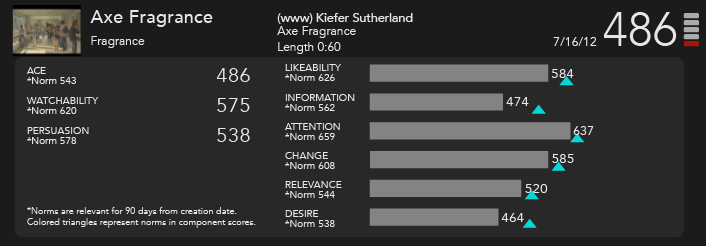
The verbatim responses showed that viewers were confused and didn’t understand the connection to Axe. Further, the responses highlighted how truly polarizing celebrities can be.

Depend’s “Great American Try-On” campaign received a top 50 spot on the Wart 100 list, coming in at #48. The highest scoring ad in this campaign was “Football Pros Try the New Depend,” which scored a 446, below the Other Personal Care category norm.
While no gender or age scored this ad above norm, it performed best with 21-35-year-old males, who gave the ad a score of 460.
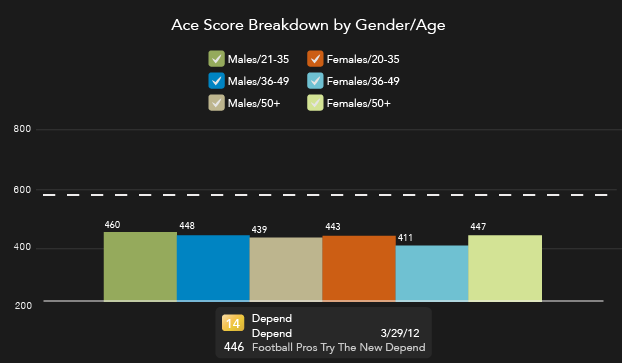
Surprisingly, the Attention component score was high, at 649, just below the norm. However, the ad lacked Information, Relevance and Desire. This is most likely because there is not a large portion of people who need this product.
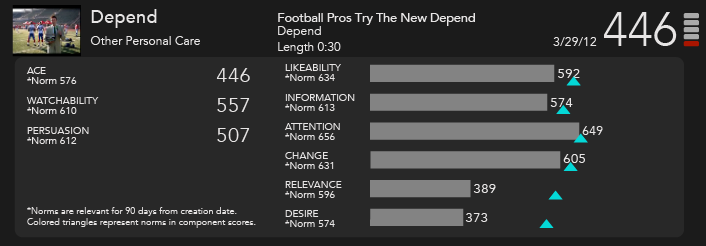
This translated to the verbatim responses, where viewers highlighted the low Relevance scores. They also emphasized the use of pro football players, which segmented the audience even further.
